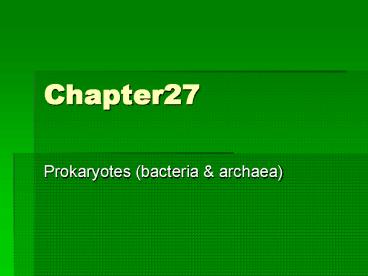Prokaryotes bacteria - PowerPoint PPT Presentation
1 / 30
Title:
Prokaryotes bacteria
Description:
The Domains separate the bacteria and the Archaea (archaebacteria) ... Numerous, short, hair-like, protein appendages. Allows adherence to each other or substrates ... – PowerPoint PPT presentation
Number of Views:195
Avg rating:3.0/5.0
Title: Prokaryotes bacteria
1
Chapter27
- Prokaryotes (bacteria archaea)
2
Domains and kingdoms
- The Kingdom Monera includes all prokaryotic
celled organisms - The bacteria and Archaea
- The Domains separate the bacteria and the Archaea
(archaebacteria) - The three domains are Bacteria, Archaea, and
Eukarya
3
Introduction
- Microscopic
- Found almost everywhere (ubiquitous)
- Vast numbers exist on earth
- Found thriving in extreme conditions
- Exhibit a wide variety of metabolic types
- Perform many essential functions for other
organisms
4
Structure, function, genetics
- Unicellular but, may aggregate into colonies
- Microscopic (average 1-5 micrometers)
- The most common shapes are
- Spheres (cocci, coccus)
- Rods (bacilli, bacillus)
- Spirals (spirochete, spirillus)
5
(No Transcript)
6
Structure
- The Inside thick liquid is the cytoplasm. It
contains water, electrolytes, nutrients, wastes,
metabolic intermediates - The DNA (chromosome) is not within a nucleus but,
exposed to the cytoplasm - Ribosomes are in the cytoplasm
- The cell (plasma) membrane is made of lipids and
proteins and encloses the cytoplasm - The cell membrane is surrounded by the cell wall
7
Prokaryotic cell walls
- Protect the cell
- Gives the cell its shape
- Made of peptidoglycan
- Still allows movement of substances into and out
of the cell - Two major types
- Gram negative Gram positive
8
Prokaryotic cell walls
- All bacteria will stain either Gram (purple) or
Gram (pink) - Used to classify bacteria
- The way they stain is a result of their cell wall
structure - It also can tell about the characteristics of
bacteria
9
Gram negative
- Has a relatively thin layer of peptidoglycan
- Has an outer membrane surrounding the
peptidoglycan - In general, more resistant to antibiotics
- Substances in outer membrane are toxic
- Outer membrane helps Gm- evade the immune system
10
(No Transcript)
11
Gram positive
- Has a thicker layer of peptidoglycan
- Does not have an outer membrane
- In general, easier to treat with antibiotics
- However, some GM bacteria are very difficult to
treat with antibiotics
12
(No Transcript)
13
Structures in some bacterial species (capsules)
- If present, capsules are located outside of the
cell wall - Made of polysaccharide or protein
- Allows adherence to each other or substrates
- Protects from the host immune system or
dehydration
14
(No Transcript)
15
Structures in some bacterial species (fimbriae or
attachment pili)
- If present, they extend from the cell membrane to
the outside of the cell - Numerous, short, hair-like, protein appendages
- Allows adherence to each other or substrates
- Shorter and more numerous than flagella
16
(No Transcript)
17
Structures in some bacterial species (flagella)
- If present, they extend from the cell membrane to
the outside of the cell - One or many, long, whip-like, protein appendages
- Allows for motility
- Longer than fimbriae
- Chemotaxis
18
(No Transcript)
19
Internal structures
- Cytoplasm
- No organelles
- No nucleus
- One, small, circular, chromosome
- May have plasmids
- Have smaller ribosomes
20
(No Transcript)
21
(No Transcript)
22
Internal structures (endospores)
- Only in some bacterial species
- A tough, resistant, structure that allows some
bacteria to survive harsh conditions - Forms inside the cell when conditions deteriorate
- Contains bacterial genetic material enzymes
- Cell ruptures and releases the endospore
- Endospore remains alive but, dormant indefinitely
- When conditions improve, endospore germinates and
grows into a bacterium
23
(No Transcript)
24
Prokaryotic reproduction (asexual)
- Most often, bacteria reproduce themselves
- The process is called binary fission
- The bacteria replicates its chromosome
- The bacteria divides into to cells each with one
chromosome - This is fast but, produces clones (genetically
identical)
25
LE 12-11_3
Cell wall
Origin of replication
Plasma membrane
E. coli cell
Bacterial chromosome
Chromosome replication begins. Soon thereafter,
one copy of the origin moves rapidly toward the
other end of the cell.
Two copies of origin
Origin
Origin
Replication continues. One copy of the origin is
now at each end of the cell.
Replication finishes. The plasma membrane grows
inward, and new cell wall is deposited.
Two daughter cells result.
26
Prokaryotic reproduction (sexual, called
conjugation)
- Produces genetic diversity
- Two bacteria of similar species join by a tube
called a sex pili - The donor cell donates DNA to the other cell
through the sex pili - The recipient cell incorporates the new DNA into
its chromosome - The new genes may code for things that help the
bacteria survive (antibiotic resistance, toxins,
capsules)
27
Prokaryotic metabolic types
- Heterotrophs
- Phototrophs
- Chemotrophs
- Autotrophs
28
Oxygen needs of prokaryotes
- Obligate aerobes
- Obligate anaerobes
- Facultative anaerobes
- Aerobic respiration
- Anaerobic respiration
29
Benefits of prokaryotes
- Nitrogen fixation
- Decomposition
- Removal of CO2
- O2 production
- Food source
30
Pathogenic bacteria
- Cause diseases by
- Exotoxins
- Endotoxins
- Digestive enzymes
- Blockage































